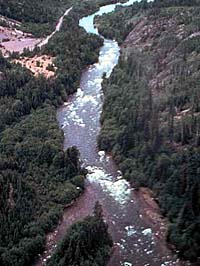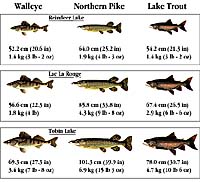
Bony fish are especially adapted to life in the water. Fishes have a vast array of physiological and anatomic specializations for defense and offense, food gathering, navigation and reproduction in the diverse aquatic habitats to which they have adapted. Modifications include:
Locomotion in waterA fish may propel itself through the water in any one of three ways: Forward motion of a fish is caused primarily by the movement of its muscular body. Every fish has interconnected W-shaped muscle segments reaching from the gills to the tail. Between each there is a silvery tissue which holds one muscle group to another. When a fish is cooked, these tissues dissolve so that the flesh (muscles) fall apart in flakes. The muscular construction enables fish to move forward in a wavy manner by driving the resistant water backwards from the body surface. The body strokes produce waves of moving water. As these waves pass along the body alternatively on each side, successive parts of the fish's body are pressed against the water. In this manner, sufficient forward forces are created to drive the fish along, even against currents. The fish's body moves from side to side -- the faster the fish swims, the more violent the movement becomes. Anyone who has caught a fish is sure to have seen this movement as the fish attempts that getaway. The narrower and slimmer the fish, the greater the size of the linked muscular contractions. Some fish can reach speeds of 36 to 54 km per hour (20 to 30 miles an hour)! Fin and tail movements play a minor role in swimming compared to body movements. A typical bony fish has two sets of paired fins (pectoral and pelvic) and a set of vertical fins (dorsal, anal and tail). Certain forward movements, maneuvering and steering are the result of the use of the fins and tail. The pectoral fins are located just behind the gill openings and these, along with the pelvic fins, aid the fish in turning, slowing and stopping. They act as brakes and rudders. Both dorsal fins (located along the middle of the fish's back) act as a keel, helping to keep the fish upright and balanced. The anal fin, located on the underside along the middle and after the anus, is unpaired and also serves as a keel. Rising and diving are achieved using the fins. Remaining motionless requires fins because the normal backward movement of water through the gills during breathing tends to move the fish forward. It has been shown through experimentation that fish are able to swim as efficiently as before, with fins reduced in size or removed altogether. The only difference is a slight loss in maneuverability. A third method of swimming is in use all of the time by a fish swimming forward. Water enters the mouth and exits the gills. The backward movement of the water moves this fish slightly forward. This method is obviously not the major method of moving the fish.
A fish breathes by drawing water into its mouth, then forcing it through its gill chambers and out via the gill slits. Inside the gill chambers, oxygen from the water is diffused into delicate filaments (gill filaments) and passes into the blood. Carbon dioxide is removed from the blood and discharged into the water. Tiny blood capillaries, embedded in the filaments, make the exchange of oxygen from the water and carbon dioxide from the fish possible. In deep lakes that freeze over in the winter, fish are not in danger of freezing to death but rather in danger of suffocating. The surface ice prevents oxygen from the atmosphere from dissolving in the lake water. The shallow lakes have much lower reserves of dissolved oxygen. Hard gill rakers on the inner border of the gill act like a sieve, preventing food materials from passing outward. The four gill openings on each side of the head are covered by flattened bones, of which the operculum is the largest. The operculum protects the delicate gills underneath.
The body of a bony fish is usually covered with scales that can overlap like the shingles on a roof. The scales themselves are dead material similar in substance to that which composes our fingernails. These scales can be either cycloid (with smooth rear edges) or ctenoid (with serrated rear edges). It is possible to determine the age of a fish from observing the number of annual growth rings which appear on each scale. Scales lost through injury are soon replaced but often they do not grow back in the same pattern as existing scales. Covering the scales is thin skin filled with many mucous glands which secrete a slimy, slippery protective coating. This slime has three important functions:
Proper handling of fish during catch and release angling is important. Care should be exercised when holding the fish; wetting hands helps to reduce the chance of the removal of the protective slime coating. Without the slime coating, the fish is vulnerable to diseases such as a fungus which infects the unprotected area.
The lateral line running along each side of the body is an open canal lying just beneath the skin and connects to the surface through pores. This canal is lined with sensory organs. These detect vibrations and changes in temperature and pressure, and help the fish to maintain its balance.
The gas-filled air or swim bladder located between the stomach and kidneys helps the fish maintain its buoyancy. The fish can alter the amount of gas (usually oxygen) in the bladder thus maintaining a chosen depth in the water without constantly swimming. When a fish is brought up suddenly from deep water, the pressure of the gas in the air bladder can cause the internal organs to be pushed out of its mouth cavity. In certain fish, the air bladder is connected to the ear by special bones and the bladder serves as a resonant cavity for sounds.
Can't see that fish in the water? Countershading (obliterative shading) enables the fish to effectively hide from its prey or predators that may be above and below. For example, a northern pike has a greenish dorsal side that, when viewed from above, blends into the lake bottom. The underside (ventral) is white and blends into the sky when viewed from below. This coloring is frequently enhanced by blotches, spots and bars conflicting patterns that tend to break up the outline of its body.
|
|||||||||

